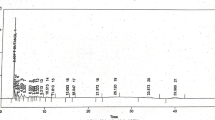Abstract
Seventy samples sold in the Brazilian market as extra virgin olive oil (EVOO) were evaluated for the presence of the 13 polycyclic aromatic hydrocarbons (PAH) classified as carcinogenic and genotoxic by the Joint FAO/WHO Expert Committee on Food Additives (JECFA), to verify if the products were adulterated and to evaluate if there is a correlation between PAH presence and adulteration. PAH were detected in 93% of the samples, with summed levels varying from not detected to 41.10 μg/kg. Five samples showed BaP concentration above acceptable levels set by European legislation and by Brazilian regulation (2.0 μg/kg) and 7 presented PAH4 levels above the limit set by European legislation (10.0 µg/kg). The levels of fatty acid composition, sterols content, stigmastadiene and specific extinction did not comply with both Brazilian and International Olive Council (IOC) standards in 18, 31, 30 and 21% of the samples, respectively. The tolerance levels for these analyses in the Brazilian standards are 55.0–83.0 g/100 g (oleic acid), 3.5–21.0 g/100 g (linoleic acid), ≤0.05 g/100 g (trans-oleic acid), ≤0.05 g/100 g (trans-linoleic + trans-linolenic acid), ≤0.15 mg/kg (stigmastadiene), ≤2.50 (K232), ≤0.22 (K270), ≤0.01 (∆K), 1000–1600 mg/kg (Σ sterols). Results indicate that 19 samples were adulterated. According to principal component analysis, samples were distinguished as: (1) EVOO with addition of vegetable oil from another source, (2) EVOO with addition of refined oil and (3) samples possibly not adulterated. The variable ΣPAH was related mainly to samples of EVOO with addition of vegetable oil from another source.


Similar content being viewed by others
References
EFSA-European Food Safety Authority (2008) Polycyclic aromatic hydrocarbons in food, Scientific opinion of the panel on contaminants in the food chain. EFSA J 724:1–114
Rey-Salgueiro L, Martínez-Carballo E, Sonia García-Falcón M, González-Barreiro C, Simal-Gándara J (2009) Occurrence of polycyclic aromatic hydrocarbons and their hydroxylated metabolites in infant foods. Food Chem 115:814–819
Rey-Salgueiro L, Martínez-Carballo E, Sonia García-Falcón M, Simal-Gándara J (2009) Survey of polycyclic aromatic hydrocarbons in canned bivalves and investigation of their potential source. Food Res Int 42:983–988
Camargo MCR, Antoniolli PR, Vicente E, Tfouni SAV (2011) Polycyclic aromatic hydrocarbons in Brazilian commercial soybean oils and dietary exposure. Food Addit Contam Part B 4:152–159
Camargo MCR, Antoniolli PR, Vicente E (2012) Evaluation of polycyclic aromatic hydrocarbons content in different stages of soybean oils processing. Food Chem 135:937–942
IARC (2012). Monographs on the evaluation of carcinogenic risk to humans. In: a review of human carcinogens: chemical agents and related occupations (Vol. 100F). Lyon, France: IARC
WHO-World Health Organization. (2005) Summary and conclusions of the sixty-fourth meeting of the Joint FAO/WHO Expert Committee on Food Additives. Rome, p 47
Rodríguez-Acuña R, Pérez-Camino MC, Cert A, Moreda W (2008) Polycyclic aromatic hydrocarbons in Spanish olive oils: relationship between benzo(a)pyrene and total polycyclic aromatic hydrocarbon content. J Agric Food Chem 56:10428–10432
Aued-Pimentel S, Takemoto E, Minazzi-Rodrigues RS, Badoloto ESG (2002) Azeite de oliva: incidência de adulterações entre os anos de 1993 e 2000. Rev Inst Adolf Lutz 61:69–75
Aued-Pimentel S, Takemoto E, Kumagai EE, Cano CB (2008) Determinação de diferença entre o valor real e o teórico do triglicerídeo ECN 42 para a detecção de adulteração em azeites de oliva comercializados no Brasil. Quím Nova 31:31–34
IOC-International Olive Council (2016). Trade standard applying to olive oils and olive pomace oils. COI/T.15/NC No3/Rev. 11
Tfouni SAV, Padovani GR, Reis RM, Furlani RPZ, Camargo MCR (2014) Incidence of polycyclic aromatic hydrocarbons in vegetable oil blends. Food Control 46:539–543
Brasil. Ministério da Agricultura, Pecuária e Abastecimento – MAPA. Instrução Normativa 1, de 30 de janeiro de 2012. Regulamento Técnico do Azeite de Oliva e do Óleo de Bagaço de Oliva. Diário Oficial da União, Brasília, DF, 01 de fevereiro de 2012
Camargo MCR, Antoniolli PR, Vicente E (2011) HPLC-FLD simultaneous determination of 13 polycyclic aromatic hydrocarbons: validation of analytical procedure for soybean oils. J Braz Chem Soc 22:1354–1361
AOCS. Official Methods and Recommended Practices of the AOCS (2014) 6th Ed., Urbana, IL, USA, Official Method ch 5-91
AOCS. Official Methods and Recommended Practices of the AOCS (2014) 6th Ed., Urbana, IL, USA, Official Method ce 1a-13
AOAC International (2010) Official methods of analysis of AOAC international (2010) 18th Ed., Gaithersburg, MD, USA, Official Method 996.06
Hartman L, Lago RCA (1973) Rapid preparation of fatty acid methyl esters from lipids. Lab Pract 22(8):475–481
AOCS. Official Methods and Recommended Practices of the AOCS (2014) 6th Ed., Urbana, IL, USA, Official Method cd 26–96
Almeida CAS (2009) Avaliação dos principais fitosteróis em óleos vegetais e azeites. Faculdade de Engenharia de Alimentos. Universidade Estadual de Campinas, Campinas
CEC-The Commission of the European Communities (2011) Commission Regulation (EC) No 835/2011 of 19 August 2011. Official Journal of European Union
Camargo MCR, Toledo MCF (2003) Polycyclic aromatic hydrocarbons in Brazilian vegetables and fruits. Food Control 14:49–53
Ergönül PG, Sánchez S (2013) Evaluation of polycyclic aromatic hydrocarbons content in different types of olive and olive pomace oils produced in Turkey and Spain. Eur J Lipid Sci Technol 115:1078–1084
Krajian H, Odeh A (2014) Polycyclic aromatic hydrocarbons in Syrian olive oils and their likely daily intakes. Toxicol Environ Chem 96:342–352
Alomirah H, Al-Zenki S, Husain A, Sawaya W, Ahmed N, Gevao B, Kannan K (2010) Benzo[a]pyrene and total polycyclic aromatic hydrocarbons (PAH) levels in vegetable oils and fats do not reflect the occurrence of the eight genotoxic PAH. Food Addit Contam Part A 27:869–878
Acknowledgements
This work was supported by the Fundação de Amparo à Pesquisa do Estado de São Paulo (Fapesp) under grant 2011/10966-4. N.P.L.A (Instituto de Química, UNICAMP, Campinas, SP, Brazil) and R.M.R. (Faculdade Jaguariúna, FAJ, Jaguariúna, SP, Brazil) thank CNPq (Conselho Nacional de Desenvolvimento Científico e Tecnológico), Brazil for the PIBIC/CNPq program undergraduate student fellowships.
Author information
Authors and Affiliations
Corresponding author
About this article
Cite this article
Tfouni, S.A.V., Reis, R.M., Amaro, N.P.L. et al. Adulteration and Presence of Polycyclic Aromatic Hydrocarbons in Extra Virgin Olive Oil Sold on the Brazilian Market. J Am Oil Chem Soc 94, 1351–1359 (2017). https://doi.org/10.1007/s11746-017-3046-3
Received:
Revised:
Accepted:
Published:
Issue Date:
DOI: https://doi.org/10.1007/s11746-017-3046-3




